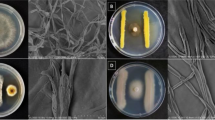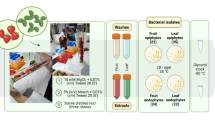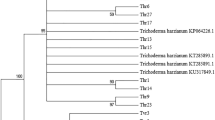Abstract
Strawberry tree (Arbutus unedo, Ericaceae) is an evergreen tree with a circum-Mediterranean distribution. It has a great ecological and economic importance as a source of bioactive compounds with industrial applications and for fruit production. This study aims to characterize the fungi microbiome of this forestry species in order to develop biological control strategies in the increasing orchard production area. For this purpose, fungi endophytes were isolated from wild strawberry tree plants, and a molecular identification was carried out. In vitro assays were carried out to evaluate and characterize the antagonism of some endophytes. Among the several fungi endophytes isolated from strawberry tree (a total of 53 from 20 genera), a Trichoderma atroviride strain proved to have antagonism effect against several phytopathogens, including Alternaria alternata, Botrytis cinerea, Glomerella cingulata, and Mycosphaerella aurantia. This antagonism was particularly effective against Phytophthora cinnamomi, causing a reduction in growth of about 80% on this invasive oomycete. An enzymatic assay revealed the production of several enzymes by T. atroviride, such as cellulases, chitinases, glucosidases, alkaline phosphatases, and proteases, which is one of the several mechanisms known to be involved on Trichoderma biological control ability. The enzymatic activity, in particular that of cell wall–degrading enzymes, was accentuated when in a dual culture with P. cinnamomi. The production of serine proteases, aspartyl proteases, metalloproteases, and cysteine proteases was also detected in an experiment carried out in liquid medium, suggesting the involvement of these proteases on Trichoderma mycoparasitism mechanisms. Finally, in a three-way interaction with in vitro strawberry tree plants, the T. atroviride strain identified on this study (Au50) was able to protect the plants against P. cinnamomi, thus proving its potential as a biological control agent.









Similar content being viewed by others
References
Aktar W, Sengupta D, Chowdhury A (2009) Impact of pesticides use in agriculture: their benefits and hazards. Interdiscip Toxicol 2:1–12. https://doi.org/10.2478/v10102-009-0001-7
Alcock A, Elmer P, Marsden R, Parry F (2015) Inhibition of Botrytis cinerea by epirodin: a secondary metabolite from New Zealand isolates of Epicoccum nigrum. J Phytopathol 163:841–852. https://doi.org/10.1111/jph.12383
Anderson WC (1980) Tissue culture propagation of red and black raspberries, Rubus idaeus and R. occidentalis. Acta Hortic 112:13–20
Andrade-Hoyos P, Silva-Rojas H, Romero-Arenas O (2020) Endophytic Trichoderma species isolated from Persea americana and Cinnamomum verum roots reduce symptoms caused by Phytophthora cinnamomi in Avocado. Plants 9:1220. https://doi.org/10.3390/plants9091220
Atanasova L, Le Crom S, Gruber S, Coulpier F, Seidl-Seiboth V, Kubicek CP, Druzhinina IS (2013) Comparative transcriptomics reveals different strategies of Trichoderma mycoparasitism. BMC Genomics 14:121. https://doi.org/10.1186/1471-2164-14-121
Bae S, Kumar T, Young J, Ryu M, Park G, Shim S, Hong S, Seo H, Bae D, Bae I, Kim J, Bae H (2016) Trichoderma metabolites as biological control agents against Phytophthora pathogens. Biol Control 92:128–138. https://doi.org/10.1016/j.biocontrol.2015.10.005
Bardin M, Ajouz S, Comby M, Lopez-Ferber M, Graillot B, Siegwart M, Nicot PC (2015) Is the efficacy of biological control against plant diseases likely to be more durable than that of chemical pesticides? Front Plant Sci 6. https://doi.org/10.3389/fpls.2015.00566
Benítez T, Rincón A, Limón M, Codón A (2004) Biocontrol mechanisms of Trichoderma strains. Int Microbiol 7:249–260
Borges E (2014) Fungos endofíticos de Arbutus unedo L.: diversidade, propriedades antimicrobianas e composição volátil. Master Thesis, Instituto Politécnico de Bragança e Universidade de Salamanca
Bradford MM (1976) A rapid and sensitive method for the quantitation of microgram quantities of protein utilizing the principle of protein-dye binding. Anal Biochem 72:248–254. https://doi.org/10.1016/0003-2697(76)90527-3
Brotman Y, Briff E, Viterbo A, Chet I (2020) Role of swollenin, an expansin-like protein from Trichoderma, in plant root colonization. Plant Physiol 147:779–789. https://doi.org/10.1104/pp.108.116293
Chen H (2018) VennDiagram: generate high-resolution Venn and Euler plots. R package version 1(6):20 https://CRAN.R-project.org/package=VennDiagram
R Core Team (2020) R: A language and environment for statistical computing. R Foundation for Statistical Computing, Vienna, Austria. https://www.R-project.org/
De Fossard R, Nitsch C, Cresswell R, Lee C (1974) Tissue and organ culture of Eucalyptus. N Z J Sci 4:267–278
Dennis C, Webster J (1971) Antagonistic properties of species-groups of Trichoderma: III. Hyphal interaction. Trans Br Mycol Soc 57:363–369. https://doi.org/10.1016/s0007-1536(71)80050-5
Downer AJ, Menge JA, Pond E (2001) Effects of cellulolytic enzymes on Phytophthora cinnamomi. Phytopathology 91:839–846
Faeth SH, Fagan WF (2002) Fungal endophytes: common host plant symbionts but uncommon mutualists. Integr Comp Biol 42:360–368. https://doi.org/10.1093/icb/42.2.360
Ferraris L, Cardinale F, Matta A (1996) In vitro production of cell wall degrading enzymes by Phytophthora capsici Leon. Phytopathol Mediterr 35:199–206
Ferreira FV, Herrmann-Andrade AM, Calabrese CD, Bello F, Vázquez D, Musumeci MA (2020) Effectiveness of Trichoderma strains isolated from the rhizosphere of citrus tree to control Alternaria alternata, Colletotrichum gloeosporioides and Penicillium digitatum A21 resistant to pyrimethanil in post-harvest oranges. J Appl Microbiol 129:712–727. https://doi.org/10.1111/jam.14657
Firáková S, Šturdíková M, Múčková M (2007) Bioactive secondary metabolites produced by microorganisms associated with plants. Biologia (Bratisl) 62:251–257. https://doi.org/10.2478/s11756-007-0044-1
Gardes M, Bruns TD (1993) ITS primers with enhanced specificity for basidiomycetes - application to the identification of mycorrhizae and rusts. Mol Ecol 2:113–118. https://doi.org/10.1111/j.1365-294X.1993.tb00005.x
Gehlenborg N (2019) UpSetR: a more scalable alternative to Venn and Euler diagrams for visualizing intersecting sets. R package version 1.4.0. https://CRAN.R project.org/package=UpSetR
Gomes F, Canhoto JM (2009) Micropropagation of strawberry tree (Arbutus unedo L.) from adult plants. Vitr Cell Dev Biol - Plant 45:72–82. https://doi.org/10.1007/s11627-008-9164-8
Grinyer J, Hunt S, Mckay M, Herbert B, Nevalainen H (2005) Proteomic response of the biological control fungus Trichoderma atroviride to growth on the cell walls of Rhizoctonia solani. Curr Genet 47:381–388. https://doi.org/10.1007/s00294-005-0575-3
Gu Z, Eils R, Schlesner M (2016) Complex heatmaps reveal patterns and correlations in multidimensional genomic data. Bioinformatics 32:2847–2849. https://doi.org/10.1093/bioinformatics/btw313
Gupta P, Ravi I, Sharma V (2012) Induction of β-1,3-glucanase and chitinase activity in the defense response of Eruca sativa plants against the fungal pathogen Alternaria brassicicola. J Plant Interact 8:155–161. https://doi.org/10.1080/17429145.2012.679705
Guzmán-Guzmán P, Alemán-Duarte MI, Delaye L, Herrera-Estrella A, Olmedo-Monfil V (2017) Identification of effector-like proteins in Trichoderma spp. and role of a hydrophobin in the plant-fungus interaction and mycoparasitism. BMC Genet 18:1–20. https://doi.org/10.1186/s12863-017-0481-y
Hermosa RL, Woo S, Lorito M, Monte E (2010) Proteomic approaches to understand Trichoderma biocontrol mechanisms and plant interactions. Curr Proteomics 7:298–305. https://doi.org/10.2174/157016410793611783
Hermosa R, Viterbo A, Chet I, Monte E (2012) Plant-beneficial effects of Trichoderma and of its genes. Microbiology 158:17–25. https://doi.org/10.1099/mic.0.052274-0
Hildebrand PD, McRae KB, Lu X (2001) Factors affecting flower infection and disease severity of lowbush blueberry by Botrytis cinerea. Can J Plant Pathol 23:364–370. https://doi.org/10.1080/07060660109506957
Jung T, Pérez-Sierra A, Durán A, Jung MH, Balci Y, Scanu B (2018) Canker and decline diseases caused by soil- and airborne Phytophthora species in forests and woodlands. Persoonia Mol Phylogeny Evol Fungi 40:182–220. https://doi.org/10.3767/persoonia.2018.40.08
Kelley WD, Rodriguez Kabana R (1976) Competition between Phytophthora cinnamomi and Trichoderma spp. in autoclaved soil. Can J Microbiol 22:1120–1127. https://doi.org/10.1139/m76-163
Knop W (1865) Quantitative Utersuchungen Über den Ernährungensprozeß der Pflanze. Landw Versuchssat 7:93
Knudsen GR, Dandurand L-MC (2014) Ecological complexity and the success of fungal biological control agents. Adv Agric 2014:1–11. https://doi.org/10.1155/2014/542703
Krijger J-J, Thon MR, Deising HB, Wirsel SG (2014) Compositions of fungal secretomes indicate a greater impact of phylogenetic history than lifestyle adaptation. BMC Genomics 15:722. https://doi.org/10.1186/1471-2164-15-722
Kusari S, Hertweck C, Spiteller M (2012) Chemical ecology of endophytic fungi: origins of secondary metabolites. Chem Biol 19:792–798. https://doi.org/10.1016/j.chembiol.2012.06.004
Lahlali R, Bajii M, Jijakli MH (2007) Isolation and evaluation of bacteria and fungi as biological control agents against Rhizoctonia solani. Commun Agric Appl Biol Sci 72:973–982
Li TT, Di Zhang J, Tang JQ, Liu ZC, Li YQ, Chen J, Zou LW (2020) Combined use of Trichoderma atroviride CCTCCSBW0199 and brassinolide to control Botrytis cinerea infection in tomato. Plant Dis 104:1298–1304. https://doi.org/10.1094/PDIS-07-19-1568-RE
Macías-Rodríguez L, Guzmán A, Guzmán-G ´ Omez G, García-Jú Arez P, Contreras-Cornejo HA (2018) Trichoderma atroviride promotes tomato development and alters the root exudation of carbohydrates, which stimulates fungal growth and the biocontrol of the phytopathogen Phytophthora cinnamomi in a tripartite interaction system. FEMS Microbiol Ecol 94:137. https://doi.org/10.1093/femsec/fiy137
Martin R, Gazis R, Skaltsas D, Chaverri P, Hibbett D (2015) Unexpected diversity of basidiomycetous endophytes in sapwood and leaves of Hevea. Mycologia 107:284–297. https://doi.org/10.3852/14-206
Martins JF, Santos T, Correia SI, Canhoto JM (2016) Somatic embryogenesis in Arbutus unedo L. and other Ericaceae. In: Park YSJB (ed) Moon HK (eds) Vegetative propagation of forest trees. National Institute of Forest Science, Seoul, pp 565–590
Martins JF, Correia S, Correia B, Pinto G, Canhoto JM (2019) Shoot proliferation and organogenesis on Arbutus unedo: physiological analysis under water stress. Biol Plant 63:278–286. https://doi.org/10.32615/bp.2019.032
Martins J, Monteiro P, Pinto G, Canhoto J (2021) Hybridization assays in strawberry tree toward the identification of plants displaying increased drought tolerance. Forests 12:148. https://doi.org/10.3390/f12020148
McIntyre JL, Hankin L (1978) An examination of enzyme production by Phytophthora spp. on solid and liquid media. Can J Microbiol 24:75–78. https://doi.org/10.1139/m78-015
Morán-Diez ME, Carrero-Carrón I, Belén Rubio M, Jiménez-Díaz RM, Monte E, Hermosa R (2019) Transcriptomic analysis of Trichoderma atroviride overgrowing plant-wilting Verticillium dahliae reveals the role of a new m14 metallocarboxypeptidase CPA1 in biocontrol. Front Microbiol 10:1120. https://doi.org/10.3389/fmicb.2019.01120
Morath SU, Hung R, Bennett JW (2012) Fungal volatile organic compounds: a review with emphasis on their biotechnological potential. Fungal Biol Rev 26:73–83. https://doi.org/10.1016/j.fbr.2012.07.001
Morelli M, Bahar O, Papadopoulou KK, Hopkins DL, Obradović A (2020) Role of endophytes in plant health and defense against pathogens. Front Plant Sci 11:1312. https://doi.org/10.3389/fpls.2020.01312
Munné-Bosch S, Peñuelas J (2004) Drought-induced oxidative stress in strawberry tree (Arbutus unedo L.) growing in Mediterranean field conditions. Plant Sci 166:1105–1110. https://doi.org/10.1016/j.plantsci.2003.12.034
Murashige T, Skoog F (1962) A revised medium for rapid growth and bio assays with tobacco tissue cultures. Physiol Plant 15:473–497. https://doi.org/10.1111/j.1399-3054.1962.tb08052.x
Okane I, Nakagiri A, Ito T (1998) Endophytic fungi in leaves of ericaceous plants. Can J Bot 76:657–663. https://doi.org/10.1139/b98-032
Pan L, Wen S, Yu J, Lu L, Zhu X, Zhang Z (2020) Genome-wide identification of M35 family Metalloproteases in Rhizoctonia cerealis and functional analysis of RcMEP2 as a virulence factor during the fungal infection to Wheat. Int J Mol Sci 21:2984. https://doi.org/10.3390/ijms21082984
Polizzi G, Aiello D, Guarnaccia V, Vitale A, Perrone G, Stea G (2011) First report of damping-off on strawberry tree caused by Colletotrichum acutatum and C. simmondsii in Italy. Plant Dis 95:1588. https://doi.org/10.1094/PDIS-07-11-0567
Pozo MJ, Baek JM, García JM, Kenerley CM (2004) Functional analysis of tvsp1, a serine protease-encoding gene in the biocontrol agent Trichoderma virens. Fungal Genet Biol 41:336–348. https://doi.org/10.1016/j.fgb.2003.11.002
Purmale L, Apine I, Nikolajeva V, Grantina L, Verkley G, Tomsone S (2012) Endophytic fungi in evergreen rhododendrons cultivated in vitro and in vivo. Environ Exp Biol 10:1–7
Qi W, Zhao L (2013) Study of the siderophore-producing Trichoderma asperellum Q1 on cucumber growth promotion under salt stress. J Basic Microbiol 53:355–364. https://doi.org/10.1002/jobm.201200031
Ramírez-Cariño HF, Guadarrama-Mendoza PC, Sánchez-López, Vladimir Cuervo-Parra JA, Ramírez-Reyes T, Dunlap C, Valadez-Blanco R (2020) Biocontrol of Alternaria alternata and Fusarium oxysporum by Trichoderma asperelloides and Bacillus paralicheniformis in tomato plants. Antonie Van Leeuwenhoek 113:1247–1261. https://doi.org/10.1007/s10482-020-01433-2
Rodriguez RJ, White JF, Arnold AE, Redman RS (2009) Fungal endophytes: diversity and functional roles. New Phytol 182:314–330. https://doi.org/10.1111/j.1469-8137.2009.02773.x
Romero-Martin MA, Trapero-Casas A (2003) La mancha foliar del madroño (Arbutus unedo) causada por Septoria unedonis var. vellanensis. Bol Sanid Veg Plagas 29:375–392
Ruocco M, Lanzuise S, Lombardi N, Woo SL, Vinale F, Marra R, Varlese R, Manganiello G, Pascale A, Scala V, Turrà D, Scala F, Lorito M (2015) Multiple roles and effects of a novel Trichoderma hydrophobin. Mol Plant-Microbe Interact 28:167–179. https://doi.org/10.1094/MPMI-07-14-0194-R
Salas-Marina MA, Isordia-Jasso MI, Islas-Osuna MA, Delgado-Sánchez P, Jiménez-Bremont JF, Rodríguez-Kessler M, Rosales-Saavedra MT, Herrera-Estrella A, Casas-Flores S (2015) The Epl1 and Sm1 proteins from Trichoderma atroviride and Trichoderma virens differentially modulate systemic disease resistance against different life style pathogens in Solanum lycopersicum. Front Plant Sci 6:1–13. https://doi.org/10.3389/fpls.2015.00077
Sena K, Crocker E, Vincelli P, Barton C (2018) Phytophthora cinnamomi as a driver of forest change: implications for conservation and management. For Ecol Manag 409:799–807
Sharma V, Salwan R, Sharma PN (2016) Differential response of extracellular proteases of Trichoderma harzianum against fungal phytopathogens. Curr Microbiol 73:419–425. https://doi.org/10.1007/s00284-016-1072-2
Sharma V, Salwan R, Sharma PN, Gulati A (2017) Integrated translatome and proteome: approach for accurate portraying of widespread multifunctional aspects of Trichoderma. Front Microbiol 8:1–13. https://doi.org/10.3389/fmicb.2017.01602
Suarez B, Rey M, Castillo P, Monte E, Llobell A (2004) Isolation and characterization of PRA1, a trypsin-like protease from the biocontrol agent Trichoderma harzianum CECT 2413 displaying nematicidal activity. Appl Microbiol Biotechnol 65:46–55. https://doi.org/10.1007/s00253-004-1610-x
Suárez MB, Sanz L, Chamorro MI, Rey M, González FJ, Llobell A, Monte E (2005) Proteomic analysis of secreted proteins from Trichoderma harzianum: identification of a fungal cell wall-induced aspartic protease. Fungal Genet Biol 42:924–934. https://doi.org/10.1016/j.fgb.2005.08.002
Sun X, Guo LD (2012) Endophytic fungal diversity: review of traditional and molecular techniques. Mycology 3:65–76. https://doi.org/10.1080/21501203.2012.656724
Torres JA, Valle F, Pinto C, García-Fuentes A, Salazar C, Cano E (2002) Arbutus unedo L. communities in southern Iberian Peninsula mountains. Plant Ecol 160:207–223. https://doi.org/10.1023/A:1015864821706
Viterbo A, Ramot O, Chernin L, Chet I (2002) Significance of lytic enzymes from Trichoderma spp. in the biocontrol of fungal plant pathogens. Antonie Van Leeuwenhoek 81:549–556. https://doi.org/10.1023/A:1020553421740
Vu VQ (2011) ggbiplot: a ggplot2 based biplot. R package version 0.55. http://github.com/vqv/ggbiplot
Waqas M, Khan AL, Kamran M, Hamayun M, Kang SM, Kim YH, Lee IJ (2012) Endophytic fungi produce gibberellins and indoleacetic acid and promotes host-plant growth during stress. Molecules 17:10754–10773. https://doi.org/10.3390/molecules170910754
White TJ, Bruns TD, Lee S, Taylor J (1990) Amplification and direct sequencing of fungal ribosomal RNA genes for phylogenetics. In: Innis MA, Gelfand DH, Sninsky JJ, White TJ (eds) PCR protocols: a guide to methods and applications. Academic Press, Inc., New York, pp 315–322
Woudenberg JHC, Seidl MF, Groenewald JZ, de Vries M, Stielow JB, Thomma BPHJ, Crous PW (2015) Alternaria section Alternaria: species, formae speciales or pathotypes? Stud Mycol 82:1–21. https://doi.org/10.1016/j.simyco.2015.07.001
Xie BB, Qin QL, Shi M, Chen LL, Shu YL, Luo Y, Wang XW, Rong JC, Gong ZT, Li D, Sun CY, Liu GM, Dong XW, Pang XH, Huang F, Liu W, Chen XL, Zhou BC, Zhang YZ, Song XY (2014) Comparative genomics provide insights into evolution of Trichoderma nutrition style. Genome Biol Evol 6:379–390. https://doi.org/10.1093/gbe/evu018
Yalage Don SM, Schmidtke LM, Gambetta JM, Steel CC (2020) Aureobasidium pullulans volatilome identified by a novel, quantitative approach employing SPME-GC-MS, suppressed Botrytis cinerea and Alternaria alternata in vitro. Sci Rep 10:4498. https://doi.org/10.1038/s41598-020-61471-8
Yike I (2011) Fungal proteases and their pathophysiological effects. Mycopathologia 171:299–323
Zhang HW, Song YC, Tan RX (2006) Biology and chemistry of endophytes. Nat Prod Rep 23:753–771. https://doi.org/10.1039/b609472b
Funding
This research was funded by the Foundation for Science and Technology (Portugal), who supported J. Martins PhD fellowship (SFRH/BD/122478/2016), ReNATURE project (CENTRO-01-0145-FEDER-000007), F4F-Forest for the future (CENTRO-08-5864-FSE-000031, Programa Operacional Regional do Centro, Fundo Social Europeu), and CULTIVAR project (CENTRO-01-0145-FEDER-000020), co-financed by the Regional Operational Programme Centro 2020, Portugal 2020, and the European Union, through the European Fund for Regional Development (ERDF). This work was carried out at the R&D Unit Center for Functional Ecology—Science for People and the Planet (CFE), with reference UIDB/04004/2020, financed by FCT/MCTES through national funds (PIDDAC) and at the Center for Neuroscience and Cell Biology (CNC) with reference UIDB/04539/2020, financed by FCT/MCTES.
Author information
Authors and Affiliations
Corresponding author
Additional information
Handling Editor: April H Hastwell
Publisher’s note
Springer Nature remains neutral with regard to jurisdictional claims in published maps and institutional affiliations.
Supplementary information
ESM 1
(DOCX 31 kb)
Fig. S1
Relative enzymatic activity (%) obtained with inhibitors cocktails for substrate Gly-Pro-AMC, with protein extracted from mycelium growing in PDA (a-d) and PDB medium (e-j). a T. atroviride on the control group (Tr). b T. atroviride in a dual culture with G. cingulata (Tr/Gc). c T. atroviride with M. aurantia (Tr/Ma). d T. atroviride with P. cinnamomi (Tr/Pc). e T. atroviride control group (Tr). f Tr/Tr – T. atroviride sub-cultured on the same medium. g Tr/Pc – T. atroviride sub-cultured on P. cinnamomi medium. h Pc – P. cinnamomi control group. i Pc/Pc – P. cinnamomi sub-cultured on the same medium. j Pc/Tr – P. cinnamomi sub-cultured on T. atroviride medium (PNG 241 kb)
Rights and permissions
About this article
Cite this article
Martins, J., Veríssimo, P. & Canhoto, J. Isolation and identification of Arbutus unedo L. fungi endophytes and biological control of Phytophthora cinnamomi in vitro. Protoplasma 259, 659–677 (2022). https://doi.org/10.1007/s00709-021-01686-2
Received:
Accepted:
Published:
Issue Date:
DOI: https://doi.org/10.1007/s00709-021-01686-2




